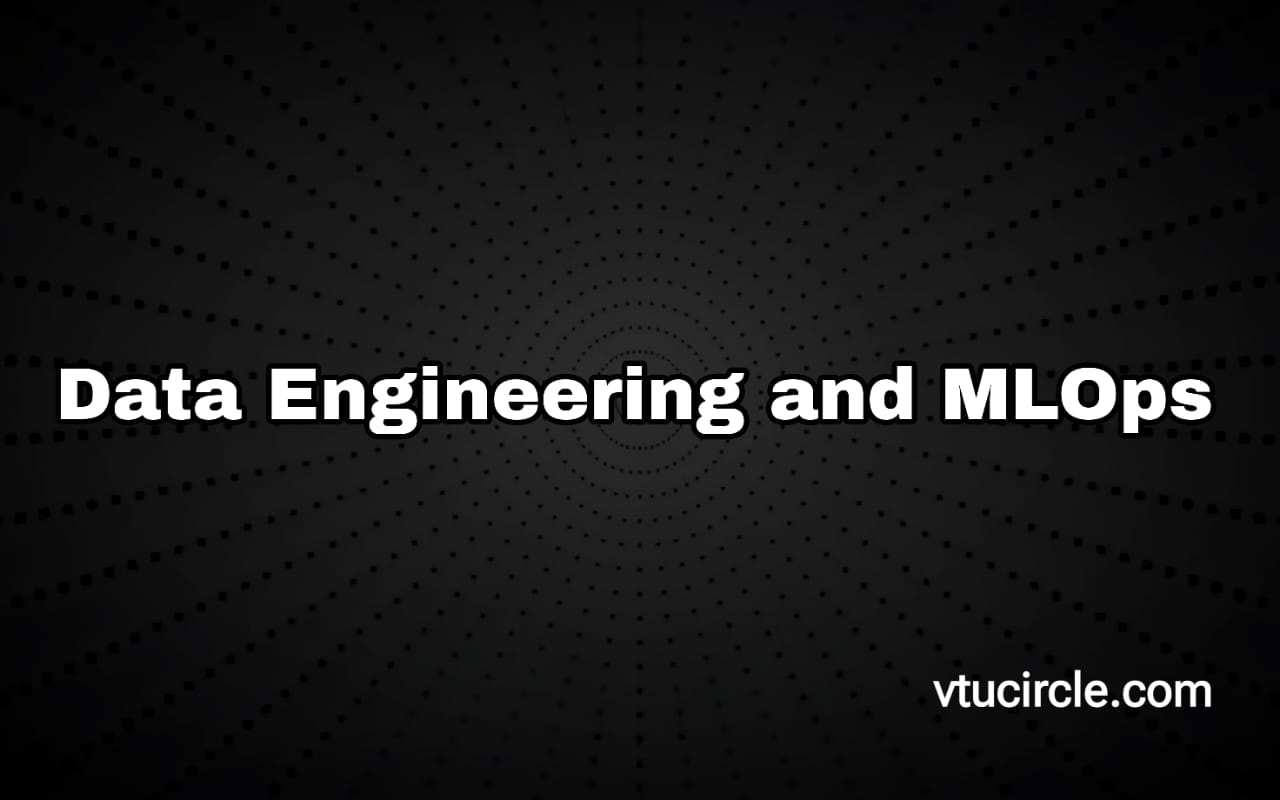Data Engineering and MLOps BAD714C
Course Code: BAD714C
Credits: 04
CIE Marks: 50
SEE Marks: 50
Total Marks: 100
Exam Hours: 03
Total Hours of Pedagogy: 50H
Teaching Hours/Weeks: [L:T:P:S] 3:0:0:0
Data Engineering: Definition, The Data Engineering Lifecycle, Evolution of the Data Engineer, Data Engineering and Data Science, Data Engineering Skills and Activities, Data Maturity and the Data Engineer,
The Background and Skills of a Data Engineer, Business Responsibilities, Technical Responsibilities, The
Continuum of Data Engineering Roles, Data Engineers Inside an Organization, Internal-Facing Versus External-Facing Data Engineers, Data Engineers and Other Technical Roles, Data Engineers and Business Leadership.
Data Engineering Lifecycle: The Data Lifecycle Versus the Data Engineering Lifecycle, Generation: Source Systems, Major Undercurrents Across the Data Engineering Lifecycle.
Data Architecture: Enterprise Architecture Defined, Data Architecture Defined, “Good” Data Architecture, Principles of Good Data Architecture, Major Architecture Concepts, Domains and Services , Distributed Systems, Scalability, and Designing for Failure ,Tight Versus Loose Coupling: Tiers, Monoliths, and
Microservices , User Access: Single Versus Multitenant , Event-Driven Architecture , Examples and Types of
Data Architecture.
Choosing Technologies Across the Data Engineering Lifecycle: Team Size and Capabilities, Speed to Market, Interoperability, Cost Optimization and Business Value, Total Cost of Ownership Total Opportunity Cost of Ownership, FinOps, Today Versus the Future: Immutable Versus Transitory Technologies: Hybrid Cloud,
Multicloud , Decentralized: Blockchain and the Edge ,Monolith Versus Modular , Serverless Versus Servers,
Server Versus Serverless evaluation.
MLOps Challenges: MLOps to Mitigate Risk, Risk Assessment, Risk Mitigation, MLOps for Responsible
AI,MLOps for Scale.
Key MLOps Features: Model Development, Establishing Business Objectives, Data Sources and Exploratory Data Analysis, Feature Engineering and Selection, Training and Evaluation, Reproducibility, Responsible AI, Productionalization and Deployment, Model Deployment Types and Contents, Model Deployment
Requirements, Monitoring.
Developing Models: Machine Learning Model, Required Components, Different ML Algorithms, Different MLOps Challenges, Data Exploration, Feature Engineering and Selection, Feature Engineering Techniques, How Feature Selection Impacts MLOps Strategy, Experimentation, Evaluating and Comparing Models,
Choosing Evaluation Metrics, CrossChecking Model Behavior, Impact of Responsible AI on Modeling, Version
Management and Reproducibility.
Preparing for Production: Runtime Environments, Adaptation from Development to Production Environments, Data Access Before Validation and Launch to Production, Final Thoughts on Runtime Environments, Model Risk Evaluation, The Purpose of Model Validation, The Origins of ML Model Risk, Quality Assurance for
Machine Learning.
Deploying to Production: CI/CD Pipelines, Building ML Artifacts, The Testing Pipeline, Deployment Strategies, Categories of Model Deployment, Considerations When Sending Models to Production, Maintenance in
Production, Containerization, Scaling Deployments, Requirements and Challenges.
Monitoring and Feedback Loop: Models Be Retrained, Understanding Model Degradation,
Ground Truth Evaluation, Input Drift Detection, Drift Detection in Practice, Example Causes of Data Drift, Input Drift Detection Techniques, The Feedback Loop, Logging, Model Evaluation, Online Evaluation.
Model Governance: Governance the Organization Needs, Matching Governance with Risk Level, Current
Regulations Driving MLOps Governance, Pharmaceutical Regulation in the US: GxP
Financial Model Risk Management Regulation, GDPR and CCPA Data Privacy Regulations, The New Wave of
AI-Specific Regulation, The Emergence of Responsible AI, Key Elements of Responsible AI (Element 1 to
Element 5), A Template for MLOps Governance (Step 1 to 8).

